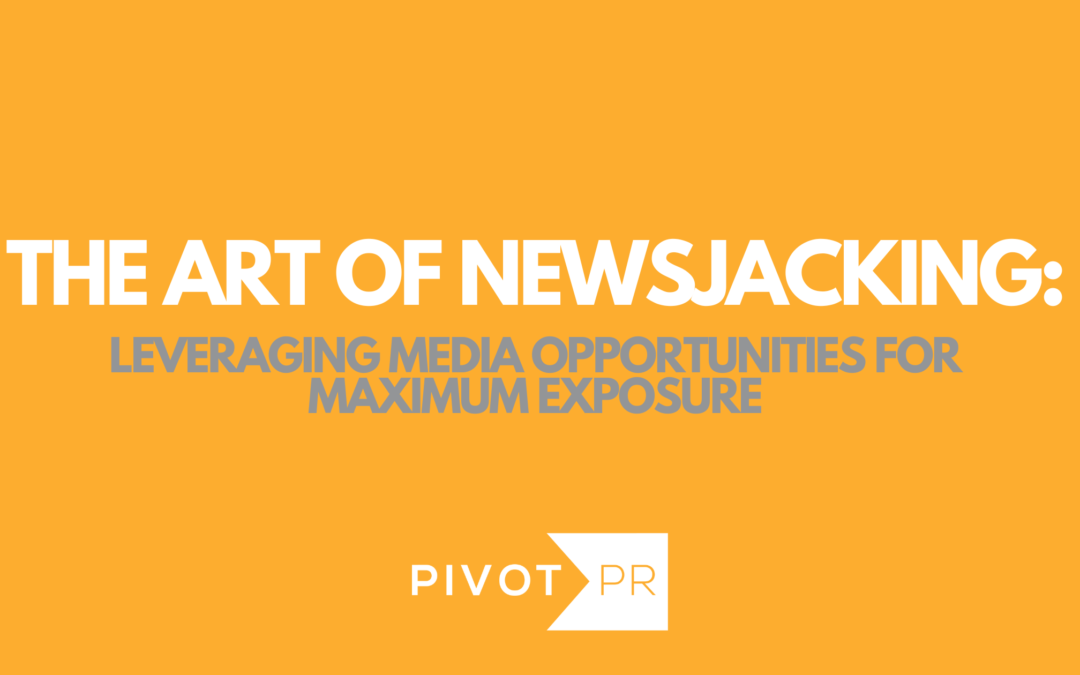
Blog
In the fast-paced industry of public relations, staying ahead of the curve is crucial. One effective strategy our team at PIVOT PR utilizes to gain media attention and boost our client’s visibility is newsjacking. This technique can bring more visibility and awareness to a brand by generating significant media coverage. In this blog post, we’ll explore what newsjacking is, why it’s effective, and how you can master this art to create impactful media opportunities.
What is Newsjacking?
Newsjacking refers to the practice of injecting your company or ideas into a breaking news story to gain media attention and amplify your brand’s message. It involves quickly reacting to news events and creating relevant content that aligns with the story, thereby positioning your brand as a thought leader in the industry.
Why Newsjacking Works
Newsjacking capitalizes on the immediacy of breaking news, making your content relevant and engaging. By associating your brand with trending topics, you increase the likelihood of being noticed by journalists, influencers, and the public.
One of the best examples of newsjacking from our team resulted in a story in The Washington Post when the largest port in Ukraine reopened during the Russia/Ukraine War. We saw the port was opening, and immediately sent out a rapid response pitch leveraging the news and offered thoughtful commentary from our client.
Steps to Successful Newsjacking
- Stay Informed: Regularly follow reputable news sources, industry blogs, and social media platforms to stay updated on current events.
- Act Quickly: The success of newsjacking hinges on your ability to act swiftly. As soon as a relevant story breaks, create content promptly and distribute it to a highly targeted media list. Ensure you have a streamlined approval process to avoid delays in publishing your content.
- Choose the Right Story: Select news stories that are relevant to your industry, brand, or audience. Avoid sensitive or controversial topics that could backfire and harm your brand’s reputation.
- Identify the Ideal Expert: Have a credible subject matter expert ready to give their expertise on the breaking story and be available for interviews if need be.
- Create Compelling Content: Offer a fresh perspective or unique insight related to the news story.
- Promote Your Content: Pitch your story to journalists and media outlets that cover your industry.
Newsjacking is a powerful tool for creating media opportunities and boosting your brand’s visibility. By staying informed, acting quickly, and crafting compelling content, you can effectively leverage breaking news stories to enhance your PR efforts. Remember, the key to successful newsjacking lies in relevance, timeliness, and authenticity.
To explore how PIVOT PR can utilize tactics such as newsjacking and more to elevate your brand’s visibility and awareness, email us at info@pivot-pr.com.
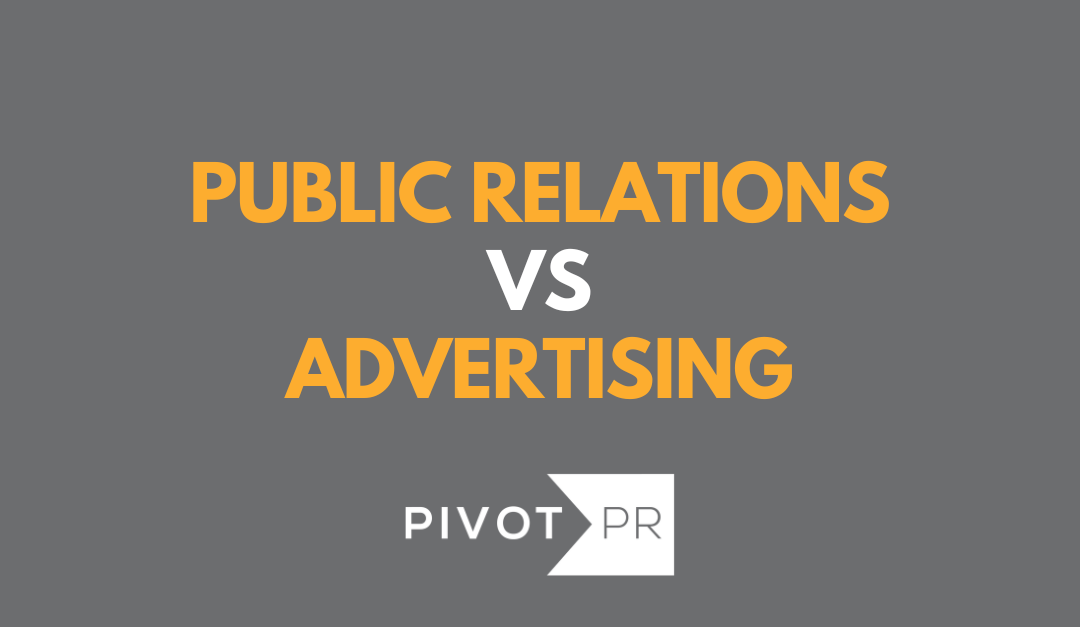
Blog
In the ever-evolving landscape of communication, the lines between public relations (PR) and advertising have often crossed. As a PR agency committed to navigating these strategic crossroads, we’re pulling back the curtain to explore the differences and similarities between PR and advertising, and what tactic you should use when.
The Differences
- Amount of Control: At its core, advertising is paid media. Brands pay for ad space and have complete control over the content, placement, and timing. PR, on the other hand, is earned media. It involves pitching stories to media outlets and influencers, relying on their interest and willingness to share your message.
- The Goal: Advertising aims to drive sales through direct and persuasive messaging about a product or service. PR is about building and maintaining a positive reputation through storytelling and relationships. These narratives don’t always have a direct call to action related to sales and focus instead on establishing trust and credibility over time.
- Lasting Impact: The impact of advertising can be powerful but sometimes short lived, as its presence has a direct correlation to the duration of a campaign’s budget. PR can often last longer, continuing to benefit a brand well beyond the initial investment.
The Similarities
Despite their differences, both PR and advertising share a common goal: to elevate a brand’s presence in the market. The two strategies aim to communicate with target audiences and shape brand perception. In the integrated marketing communications era, successful brands often leverage both PR and advertising, creating a relationship where each complements the other for maximum impact.
Navigating Which to Use When
The decision to lean toward PR or advertising hinges on your immediate goals, audience, and budget:
- For Immediate Sales and Measurable ROI: If your goal is to drive immediate sales or specific actions (for example sign-ups, downloads, etc.), and you are looking for measurable ROI metrics, advertising is your go-to. The direct and controlled nature of ads allows for targeted messages aimed at eliciting immediate responses.
- To Build Trust and Brand Authority: If your goal is to manage brand reputation, establish thought leadership, or build long-term relationships with your audience, PR will best serve your needs.
- Limited Budgets with Long-Term Vision: For startups or companies with limited budgets but a long-term vision, prioritizing PR can be a cost-effective strategy. Earned media, though challenging to secure, provides substantial credibility and audience reach without the larger price tag of paid ad spaces.
- Integrated Campaigns for Amplified Impact: When goals align and resources permit, an integrated campaign utilizing both PR and advertising can amplify your brand’s message. Advertising can increase visibility and direct responses, while PR solidifies brand’s reputation and establishes trust.
Mastering the nuances of public relations and advertising is key to crafting impactful communication strategies that shape positive brand perception and drive results. Whether you’re aiming for immediate impact or nurturing long-term trust, the choice between PR, advertising, or a strategic blend of both, holds the key to achieving heightened impact and long-lasting influence; far beyond the boundaries of a single campaign, ad, or story.
Need a hand with your PR strategy? Reach out to us at info@pivot-pr.com!
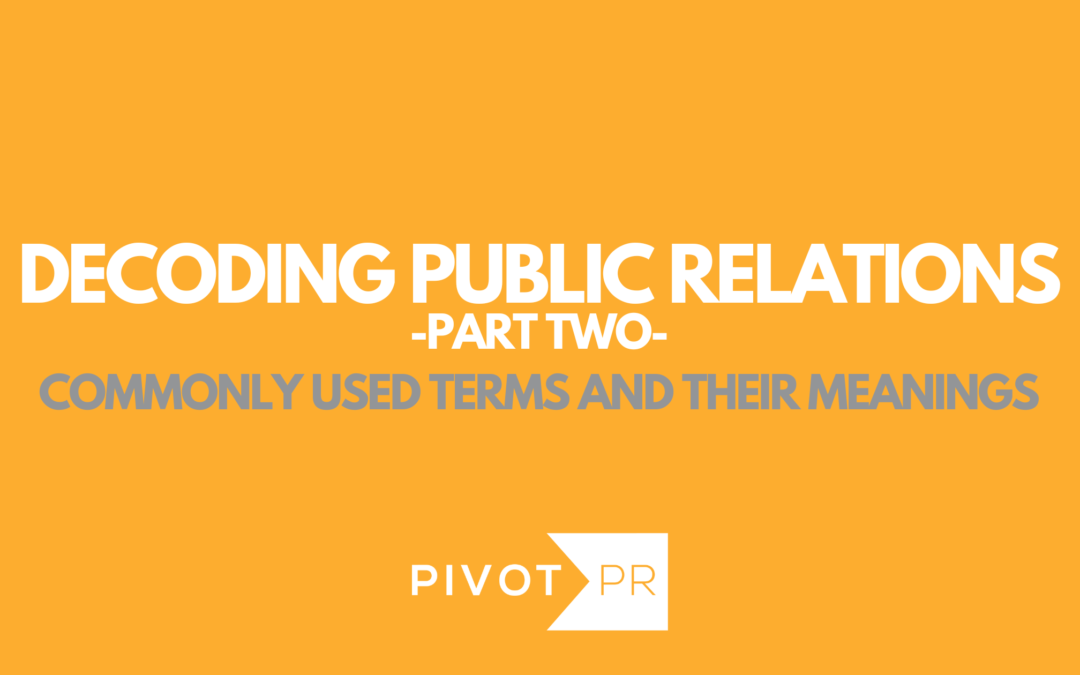
Blog
The world of public relations is jam packed with terms that can sometimes be a tad bit confusing. But don’t worry, we’re back with a sequel of “Decoding Public Relations” to further demystify some of the top phrases we see floating around in our world constantly, and what they really mean!
In this post, we will focus on ten terms specifically used in the public relations industry, carefully defining how they are used in the context of PR.
Op-Ed
Contrary to popular belief, Op-Ed does not stand for “opinion editorial.” Surprised? We were, too!
Short for “opposite the editorial,” an op-ed is an opinion piece that appears in a newspaper. This content is commonly written by a subject-matter expert, a person with a unique perspective on an issue, or a regular columnist employed by the paper. It is called “opposite the editorial” because newspapers typically place op-eds on the opposite side of an editorial page.
SEO
Ever wonder how some websites pop up on the first page of your Google search, while others are hidden in the endless scroll of later pages? That’s (SEO) magic at work. By optimizing website content with relevant keywords, tags, and backlinks, brands can increase their visibility and rank higher in search results. Consider it the behind-the-scenes work to make your website the star of the Google show.
Social Listening
Social listening allows businesses to track mentions of their brand, competitors, or their general industry online through social media, without the consumer interacting with the brands owned channels. These mentions help brands understand what consumers are saying online organically. Once a brand has this information, they can use it to tailor content, address concerns, and engage with the audience in meaningful ways.
For example: a consumer posts on Facebook asking if anyone has a recommendation for a good running shoe. One of their friends might comment “Adidas” or “Nike,” without tagging the brand. If multiple people are having a similar conversation, i.e. associating Adidas or Nike with good running shoes, this will come up as a spike in Nike / Adidas social listening. They can see that they (or their competitor) were included in numerous conversations about running shoes, which might help them better target their strategy.
Boilerplate
At the end of a press release, you often see a paragraph that seems to repeat across different releases from the same company. That’s the boilerplate. It’s a standardized text that provides a brief overview of the company, including its mission, achievements, and services.
Byline
Have you ever noticed a name right below the headline of an article? In the media world, that is called a byline. It gives credit to the author of the article.
Geotargeting
Geotargeting is a strategy that pushes content or advertisements to users based on their geographic locations. It is most commonly used by businesses who are trying to reach people in a specific area. For example, a restaurant might use geotargeting to reach people within a certain radius of their location. Anyone outside that radius might not find the ad relevant.
Influencer Marketing
Influencer marketing is when a brand taps trusted influential partners to promote a product, bridging the gap between the consumer and the brand. Influencers—ranging from content creators, micro or macro influencers, to revenue driving influencers and celebrities—are carefully selected based on the brand’s specific goals. No surprise here: the content they produce is also reflective of these goals. For example, if your goal is to sell more product, you would want to partner with an influencer who is known for driving revenue, and ask them to create a piece of content specifically encouraging their followers to buy your product.
Whitelisting
Whitelisting is an up-and-coming topic within influencer marketing. It is when a brand is given access to an influencers account and has the green light to run ads on their behalf from their channel. This arrangement tends to be a win-win: the brand gets to tap into an audience already receptive to similar content, while the influencer enjoys the perk of increased exposure through the brand’s targeted social ads.
Click-Through Rate (CTR)
Click-through rate tells you the percentage of people who click on a link or ad after seeing it. High CTR? Your ad is working! Low CTR? It might be time to try a new approach.
EdCal
An editorial calendar is a list of topics that will be discussed monthly in a magazine. It is often intended for potential advertisers; However, PR teams can also leverage this information! Many public relations professionals will use an EdCal as a strategic planning tool to help align their pitches with the media’s scheduled focus areas.
NDA
A Non-Disclosure Agreement (also referred to as an NDA) is not specific to the PR industry. However, in the realms of public relations, a Non-Disclosure Agreement (NDA) acts as a confidentiality safeguard. It legally binds all parties involved—agencies, consultants, clients, and freelancers—not to disclose proprietary insights or creative ideas until a certain date, usually the launch or release date. Having an NDA in place ensures that any sensitive information related to PR strategies, campaign specifics, client details, or product launches remains under wraps.
Whether you’re crafting your next Op-Ed or analyzing your latest campaign’s CTR, knowing these terms will help you navigate the ever-evolving landscape of public relations with ease. In case you missed it, be sure to check out our first blog post on this topic: https://pivot-pr.com/decodingpublicrelations/
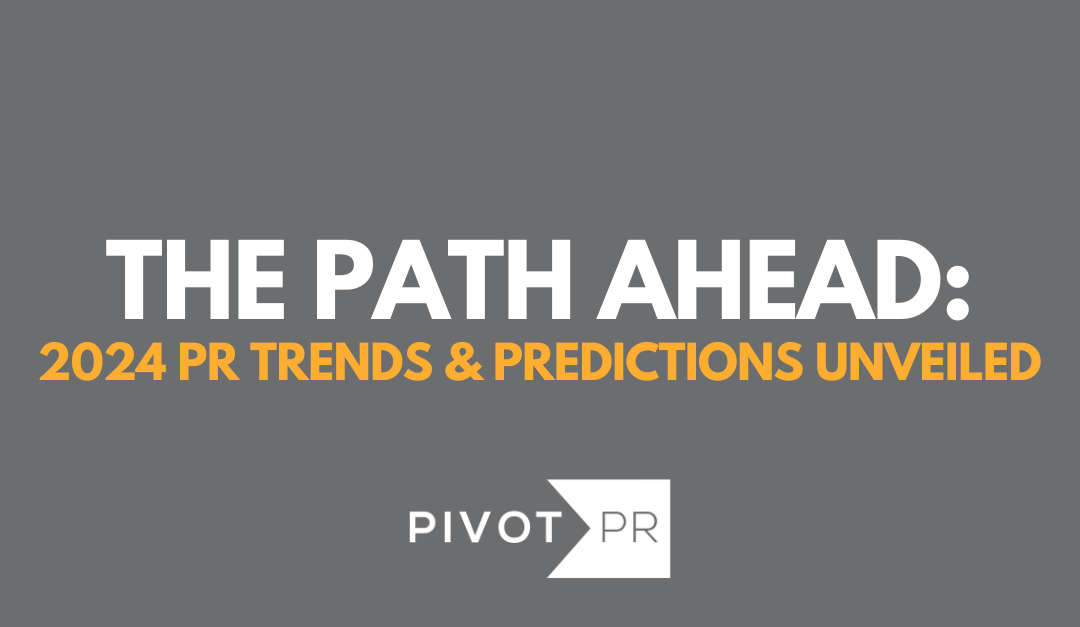
Blog
In the ever-evolving world of public relations, keeping up with the latest trends is crucial. As part of our commitment to staying at the forefront of this discipline, PIVOT PR Director Lana West recently had the opportunity to share her insights with Prowly, a leading PR software platform, on the projected PR trends for 2024.
Her insights were featured in Prowly’s much-anticipated annual trends report, contributing thought-leadership to the dialogue around the industry’s future. We’re thrilled by the reception and eager to share the complete spectrum of her predictions with you, right here on our blog.
So, what’s in store for the industry in 2024, and how should businesses prepare to take advantage of these trends? Read on to discover what we believe will shape the narrative in the world of PR for the coming year!
What will be the biggest challenge for PR Pros in 2024?
In 2024, one of the most significant challenges for PR professionals will be navigating the ever-changing digital landscape. As tools such as AI become more commonplace, and shifts in consumer behavior continue to accelerate, it is crucial for PR pros to stay ahead of the curve. Successfully adapting to emerging platforms, changing algorithms, and digital trends all while ensuring a client’s messaging remains on brand and resonates with the target audience will continue to be a juggling act.
What are outdated or ineffective PR trends that professionals should move away from in the coming year?
There are three outdated trends PR pros should leave behind in 2023. In 2024, never will we ever:
- Rely solely on press releases as a primary means of communication. In today’s dynamic media landscape, there’s a need for more personalized and targeted messaging. We strongly recommend adding a more tailored, relationship-focused approach to both media and influencer outreach.
- Use stale content on social media. It will become even more important for brands to have fresh, dynamic content to use on their social media channels. To truly stand out and connect with an audience, it’s essential to create content that is engaging, authentic, and interactive.
- Prioritize vanity metrics. The outdated practice of chasing vanity metrics, such as high follower counts, should be replaced with a focus on metrics that genuinely reflect engagement, brand loyalty, and conversions.
What will the biggest PR trend be in 2024?
We anticipate seeing a lot of brands “doing more with less” in 2024. In simple terms: amping up creativity, and getting scrappy.
Success in PR this upcoming year will rely on a blend of creativity, adaptability, and the ability to recognize and harness the power of existing trends to craft compelling narratives with little additional budget. For example, Panera Bread’s approach to the Roman Empire trend demonstrates how they creatively restructured their existing menu, to tap into a timely theme.
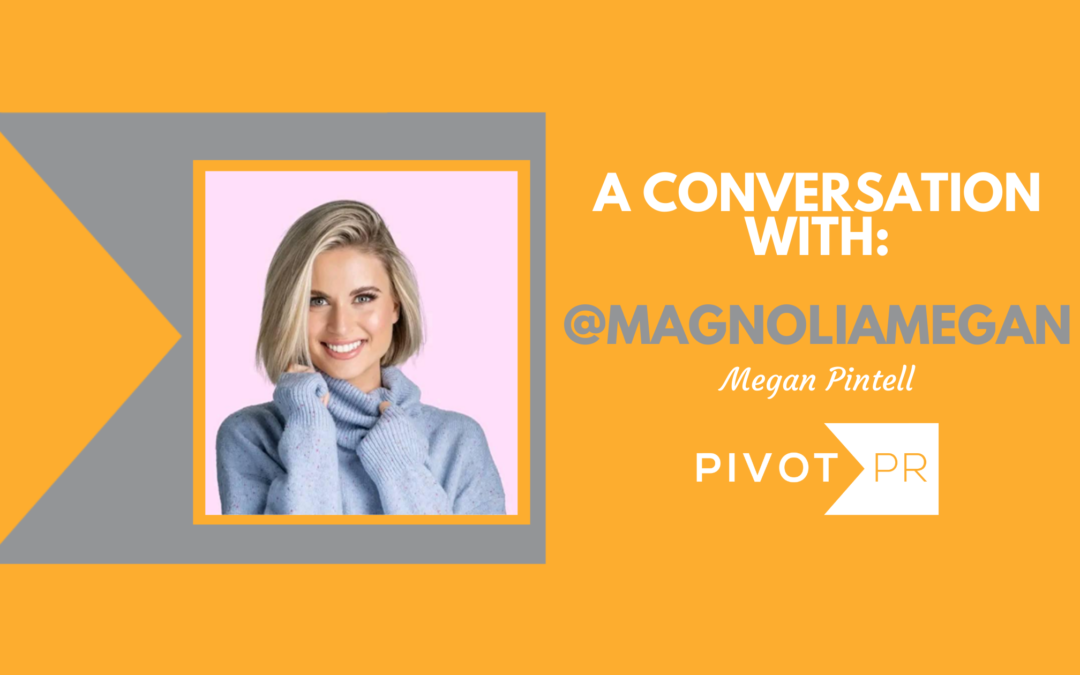
Blog
We had the privilege of sitting down with Megan Pintell of Magnolia Megan (@MagnoliaMegan, 175k followers on Instagram), and asking her some questions about how brands and agencies can best work with influencers just like her.
PIVOT recently collaborated with Megan on behalf of our client Piada Italian Street Food. Megan’s content reached over a million people, helping spread awareness of their new location opening in Raleigh, North Carolina.
Tell us a little about yourself. Where did the name Magnolia Megan come from? What inspired you to start your journey as an influencer?
The name Magnolia Megan came from a branding project in college. I have always loved magnolia flowers and so I created a logo of a hand drawn magnolia flower for my brand. It was first used for my resume, cover letter, and portfolio website and later used for my name on social media!
I’ve always been a creative person and went to school for graphic design. I grew up doing photography and first learned on film from my Grandpa. I then did plenty of art classes like ceramics, acrylic painting, oil painting, and more.
I first started thinking about social media in college around 2017/2018. It was always a thought in the back of my mind but at the time I didn’t know how to pursue it. I was too busy with school and working three jobs at the time as well as pursuing a freelance business for graphic design, mainly focusing on logos and t-shirt designs.
When I graduated, I got a job at Dick’s Sporting Good’s Inc. in their corporate office on the signage team creating signs and graphics for their stores. The job was exciting at first and I learned a lot, however, I knew I didn’t want to work a 9 to 5 my whole life.
Six months after graduating, my husband (fiancé at the time) found out he had the opportunity to relocate to Houston, TX for his job. So, we moved across the country to a massive city.
I found a job at a boutique and started working as a helper in the store running errands, organizing clothes, and helping design graphics for social media and their website. I worked my way up in a short time to then start managing their social media and that’s when my interest in social media that I had in college began again.
I loved the creativity that went into social media and I saw a lot of potential in it. I then decided to start a blog website using my Magnolia Megan name and begin posting some content on my own personal Instagram. I had no idea what I was doing with my blog at the time and after a few months, I shut it down.
Around this time, Covid happened and I also got laid off from my job at the boutique. I began to start posting things to do and food on TikTok and Instagram during Covid, and my TikTok began to gain some traction.
Another content creator who was very big in Houston reached out to me and so I began working under her creating videos for 10+ restaurant accounts, managing their social media, creating viral videos, and going on content shoots.
I learned very quickly how to create consistent viral videos and kept improving my content for these restaurants. This also helped me have content for my own account to post and I began to love social media even more because of what I saw it do for the businesses I worked for.
After two years of living in Houston, we moved on a whim to Raleigh, NC in December of 2021. With all of the experience I gained in Houston and my creative skills that I have had, I grew my own Instagram account focusing on North Carolina content from 5,000 followers in December 2021 to 170,000 in January of 2024!
How would you describe your personal brand, and how has it evolved over time?
I would consider myself a lifestyle content creator that focuses on experiences, whether it is in North Carolina, a surrounding state, or at home.
I first started focusing on food in North Carolina because I knew it was the easiest to grow with. I then expanded from there to start to include interesting places, experiences, and more.
I wanted to keep my content broad enough that I wasn’t just considered a food blogger or locked in a specific city. That is also why I used the branding I created in college and chose the name Magnolia Megan because I wanted to have a personal brand and provide value to others with the things that my husband and I were doing.
Can you share some do’s and don’ts for brands or PR professionals when they want to collaborate with influencers?
Always have a budget in mind, especially for larger influencers.
It takes a lot of hard work, time, and creativity to create social media content and it is just as effective or even more effective than traditional marketing when you work with the right person. I have worked very hard to learn what I have and to get to where I am, all while building an organic following and building trust between my followers over content I post.
It can be disheartening when larger brands want to work with you, and they don’t have a budget set aside for this type of marketing. This type of marketing is growing, so it will be exciting to see how brands and PR agencies respond in the coming years!
Before accepting a collaboration, what kind of research or due diligence do you do about the brand or team?
I look into the brand or PR agency to make sure that they are credible, and their collaboration offer is something that would work with my audience. Then, I will think of a creative concept that will work organically for my page and will resonate with my audience. I don’t want to just accept any collaboration, you have to make sure it aligns with your brand!
Also, always make sure that you read over the contract before accepting and/or send a contract for them to sign! There have been instances where I was excited about a collaboration and was emailing the agency, we had a great conversation, approved the concept, and negotiated payment. They wanted the turnaround to be quick so I went through a platform to accept their proposal, spent hours creating the content, sent it for approval, only to have a delayed response from the agency working with the brand after sending the content for approval. After a few weeks with no response and several follow ups, they told me that the brand decided they were no longer doing the collaboration.
I had already done all of the work except for posting only to be told they are no longer doing it and I won’t be compensated for my work. When I went to the platform I accepted the approval on, I realized there was no contract signed. Of course you don’t expect these things to happen and for scams to be real, but they are and it is better to take all precautions. Read over contracts and do your research. Don’t rush into a collaboration even if it seems legit.
In your opinion, what are some common mistakes brands make when reaching out to influencers?
I believe a common mistake is not doing enough research on the influencer and on payment structure for social media.
Each influencer is different – the type of content they create, the engagement rate, demographics, location, payment expectations, and more. It’s always important to also do your research into an influencer so you know who you’re working with. Will they provide the results your client is looking for? Or is their page mostly engagement groups, bots, or the wrong demographic completely?
Everyone is different and working with the right influencer can provide amazing results. Be sure to reach out to influencers that will provide the type of content you’re looking for and send a thought-out proposal so they know what kind of collaboration it is.
Be open with the pricing structure and the concept so they can create something that will resonate with their audience.
As the industry continues to change and evolve, how do you plan to adapt, and what changes do you foresee in the influencer landscape?
I am always studying analytics of my content and analyzing trends.
It is important to keep updated on how your content is performing, what your audience is reacting to, and what social media is doing at that time. The algorithms are changing constantly and the psychology behind why posts perform well is very important. If you don’t change your content or improve, it will get overlooked very quickly.
Social media is a very competitive space and that can be a good and bad thing. If influencers become complacent with how their posts are performing or with their content quality, why would brands want to use them for marketing?
Just like any other job, it is important to keep on top of your work and on all the ins and outs of social media.
What’s one thing that you want all the PR professionals to understand about working with influencers?
Influencers became influencers for a reason – because they provided useful content with value, they are creative, good at storytelling, and more. They also know their followers best and how they would react to different concepts or types of content.
Let them be creative and have room for that with the collaboration. This is not a brand’s way of pushing an ad that you would typically see in a magazine or on TV onto social media because it will most likely not get good engagement or response on their account.
When using an influencer, the best thing you can do is let them be creative and make the collaboration feel as authentic as possible toward their audience. A great creator will be able to do this and that is where the beauty of social media comes into play!
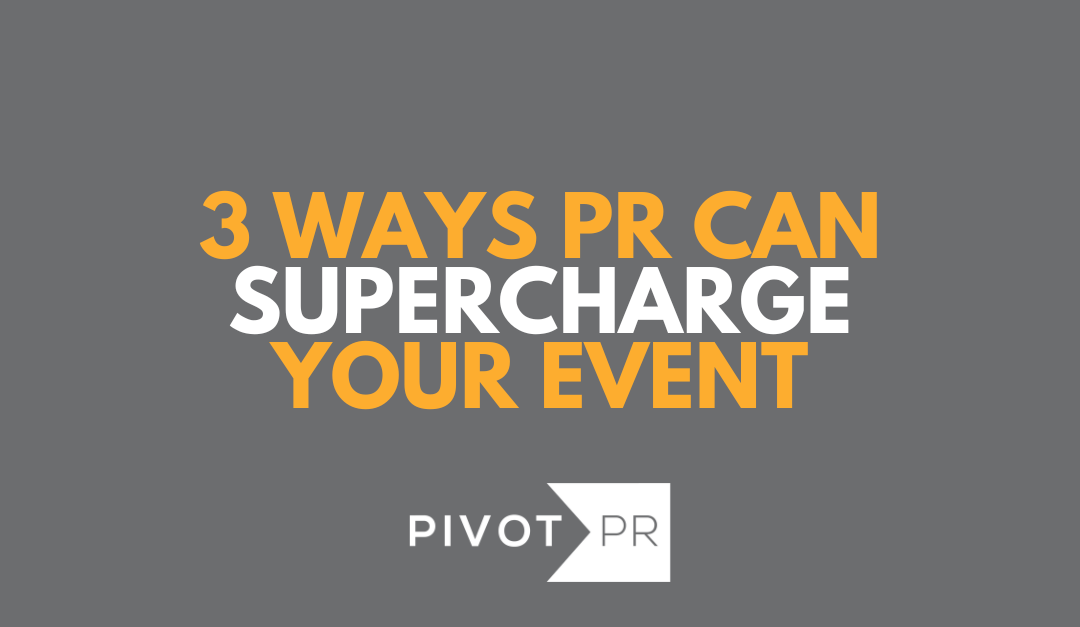
Blog
In the world of events, success isn’t just measured by the number of attendees! In fact, it’s about crafting a branded experience that resonates with your audience, sparks conversation, and leaves a lasting impression. Public relations (PR) is one of the best tools available for the events planning process, no matter your size or industry.
In this blog post, we’re exploring the connection between the two and revealing how PR strategies can transform an event from run-of-the-mill to remarkable. From building excitement before the big day to keeping the buzz alive long after it’s over, the power of PR is undeniable!
1. PR Can Build Pre-Event Anticipation
While sharing your event on your own social platforms is a great place to start, PR provides a much larger awareness boost. Public relations professionals can take your goal and target audience and develop a tailored, strategic plan that utilizes a variety of channels for maximum exposure. These efforts can include, but are not limited to:
- Drafting press releases and securing strategic media coverage and exclusive interview opportunities for digital, print, radio, and beyond.
- Creating social media teaser campaigns, countdowns, and sneak peaks to engage followers and the larger public.
- Identifying macro and/or micro influencer partnerships to help amplify your event to a new audience.
- Conducting neighborhood canvassing to deliver invitations, exclusive promotions, and more.
2. PR Can Enhance the Attendee Experience
There are a lot of moving parts to an event, so allow the experts to handle your guest experience from start to finish! A knowledgeable PR team can provide invaluable insights and guidance drawn from their wealth of event expertise, helping you craft unforgettable moments that leave a lasting impact. Here are a few ways a PR team can foster a VIP experience before, during, and after your event:
- Designing personalized invitations that create anticipation and importance around guest attendance.
- Developing a run of show for the event and/or developing speeches and talking points.
- Recommending partners or interactive experiences like photo booths and live demonstrations to inspire social sharing by guests.
- Incorporating thoughtful touches like gift bags or personalized event elements.
- Serving as an onsite point person for logistical concerns or guest questions.
- Handling post-event guest communications to ensure a positive experience.
3. PR Can Help Sustain Post-Event Momentum
The impact of your event doesn’t end when the lights dim and the guests go home. A PR team understands the importance of sustaining momentum beyond the event. They can maintain engagement by securing post-event coverage, sharing highlights and testimonials, and engaging with attendees on social media. By maximizing post-event exposure, PR helps extend the lifespan of your event’s impact and lays the groundwork for future success.
Planning an event? Reach out to us at info@pivot-pr.com!
Let us help craft a comprehensive events plan with lasting impact.





